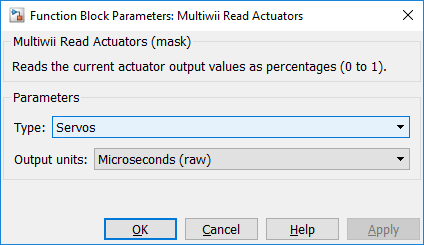

Multiwii Read Actuators
Reads the commands for the servos or motors from the auto-pilot.
Library
QUARC Targets/Communications/Multiwii MATLAB Command Line Click to copy the following command line to the clipboard. Then paste it in the MATLAB Command Window: qc_open_library('quarc_library/Communications/Multiwii')
Description

The Multiwii Read Actuators block uses the Multiwii protocol on the input stream to send a command to the aircraft to
read the servo or motor values from the auto-pilot. The Multiwii Read Actuators block sends a MSP_SERVO
or MSP_MOTOR message respectively to the auto-pilot.
This block is designed to be used with blocking I/O. It is typically used with a stream connected to a serial port. To open the stream a Multiwii Connect block should be used.
The output of the block is a variable-sized vector. The units depend on the Output units parameter. The order of the actuators depends on the auto-pilot.
A copy of the stream is also output so that the Multiwii blocks may be chained together.
If an error occurs, then the block returns a negative error code at its err output. The Compare to Error block may be used to check for specific error codes. If the stream is not valid because it is not yet connected, the err output will be zero since this condition is expected and the validity of the stream may be checked using the con output of the Multiwii Connect block.
Helpful Hints
Other uses of this block
 Although it is intended for use in the main diagram with the other Multiwii
blocks, the
Multiwii Read Actuators
block may be used
with the Advanced stream blocks, even in an asynchronous thread.
Although it is intended for use in the main diagram with the other Multiwii
blocks, the
Multiwii Read Actuators
block may be used
with the Advanced stream blocks, even in an asynchronous thread.
Input Ports
stm
A reference to the stream created by the Multiwii Connect block. If a connection has not yet been established, then the err output of the Multiwii Read Actuators block will be zero.
Output Ports
stm
A reference to the stream. This output is merely a copy of the stm input. Providing this output makes it much easier to establish the execution order of Multiwii blocks in the diagram because Simulink generally executes daisy-chained blocks in sequence.
val
This output depends on the Output units parameter. Each element of the output vector corresponds to a separate actuator. However the data type and range changes depending on the output units. Refer to the Output units parameter for details.
The output is a variable-sized vector. The order depends on the auto-pilot.
err
An int32 value indicating whether the data was read successfully. This value will be positive if data was read successfully. It will be zero if data could not be read immediately. If an error occurs then this value is a negative error code. See Error Codes for the different error codes and their values. Use the Compare to Error block rather than the error code itself to check for specific error codes. To check for errors in general use the Compare to Zero block to check whether the err output is less than zero.
Parameters and Dialog Box

Type
Select whether the servos or motors will be read.
Output units
This parameter determines the data type and units of the val output. The table below shows the output for each of the different units:
|
Units |
Data Type |
Description |
|---|---|---|
|
Bipolar percentage |
double |
Each element maps the typical [1000,2000] range to [-1,1] such that 1000 becomes -1, 1500 becomes 0 and 2000 becomes 1. Any values outside this range are mapped according to the same affine transformation. These units are useful when the RC data represent -100% to 100% throttle. |
|
Unipolar percentage |
double |
Each element maps the typical [1000,2000] range to [0,1] such that 1000 becomes 0 and 2000 becomes 1. Any values outside this range are mapped according to the same affine transformation. These units are useful when the RC data represent 0 to 100% throttle. |
|
Seconds |
double |
Each element maps the typical [1000,2000] range to [0.001,0.002] such that 1000 becomes 0.001 and 2000 becomes 0.002 so that the output is the RC pulse width in seconds. Any values outside this range are mapped according to the same affine transformation. These units are useful when the RC data are being used to drive PWM pulse widths via the HIL blocks. |
|
Microseconds (raw) |
uint16 |
Each element is the raw RC value, which is the RC pulse width in microseconds. |
Targets
|
Target Name |
Compatible* |
Model Referencing |
Comments |
|---|---|---|---|
|
Yes |
Yes |
||
|
Yes |
Yes |
||
|
Yes |
Yes |
||
|
Yes |
Yes |
||
|
Yes |
Yes |
||
|
Yes |
Yes |
||
|
Yes |
Yes |
||
|
Yes |
Yes |
||
|
Yes |
Yes |
||
|
Yes |
Yes |
||
|
Yes |
Yes |
||
|
Yes |
Yes |
||
|
Yes |
Yes |
||
|
Yes |
Yes |
Last fully supported in QUARC 2018. |
|
|
Rapid Simulation (RSIM) Target |
Yes |
Yes |
|
|
S-Function Target |
No |
N/A |
Old technology. Use model referencing instead. |
|
Normal simulation |
Yes |
Yes |
See Also

Copyright ©2025 Quanser Inc. This page was generated 2025-11-01. Submit feedback to Quanser about this page.
Link to this page.